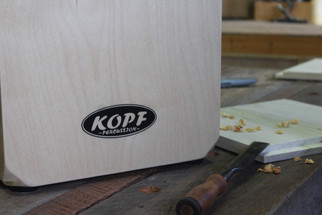Posted by Steve Head on 1st Apr 2023
The Process of Building a Cajon: A Step by Step Guide
The cajon drum is a percussion instrument that has become increasingly popular in recent years, thanks to its versatile sound and portability. In this article, we will explore the process of building a cajon drum from scratch.
The first step in building a cajon drum is selecting the wood. The most common woods used for the cajon are birch, oak, and maple, though other types of wood can also be used. The wood must be strong and durable enough to withstand the stress of being played, but also flexible enough to produce the desired sound.
Once the wood has been selected, the next step is cutting the wood into the appropriate sizes and shapes. The two sides of the cajon are typically made from one piece of wood, while the top and bottom are made from separate pieces. The sides should be approximately 19 inches in height and 11 inches in width, while the top and bottom should be around 12 inches square.
After cutting the wood, the next step is assembling the cajon. The two sides are glued and clamped together, with the top and bottom pieces added after the glue has dried. Once the main structure of the cajon is complete, the next step is cutting the sound hole.
The sound hole is typically located on the back of the cajon, and its size and shape can have a significant impact on the sound of the instrument. The sound hole should be approximately 6 inches in diameter, and it can be round, oval, or even a custom shape.
Once the sound hole has been cut, the next step is adding the snare wires. The snare wires are what give the cajon its distinctive snare sound, and they are typically made from guitar strings or wire. The snare wires are attached to the back of the top piece of the cajon, and they should be positioned so that they touch the playing surface when the cajon is played.
After the snare wires have been attached, the next step is adding the playing surface. The playing surface is typically made from a thin piece of plywood , and it should be cut to fit the top of the cajon. The playing surface should be glued and/or screwed to the top of the cajon, and it should be sanded smooth to ensure a comfortable playing experience.
Once the playing surface has been attached, the next step is finishing the cajon. The finish can have a significant impact on the appearance and sound of the cajon, and there are many options available. Some popular finishes include natural wood, stain, and paint.
Finally, the cajon drum must be tuned. Tuning the cajon involves adjusting the snare wires and playing surface to produce the desired sound. The snare wires can be adjusted by tightening or loosening them, while the playing surface can be adjusted by sanding or adding material.
The tuning process can be time-consuming, but it is essential to ensure that the cajon produces the best possible sound. A well-tuned cajon will have a clear and resonant sound, with a crisp snare sound and a deep bass tone.
In conclusion, building a cajon drum is a complex process that requires skill and attention to detail. From selecting the wood to tuning the finished instrument, every step of the process is important to ensure that the cajon produces the desired sound.
As an Amazon Associate, I earn from qualifying purchases. This means that if you click on the link and make a purchase, I may receive a small commission at no extra cost to you. This helps support my work in providing quality content. Thank you for your support!
Please check out my other blog post:


